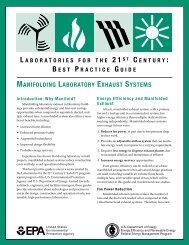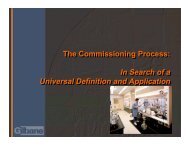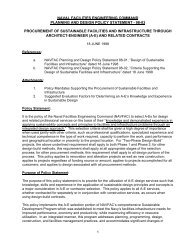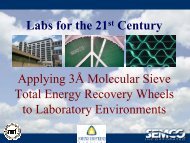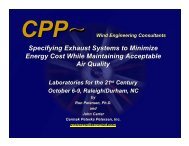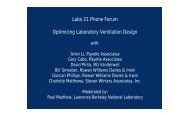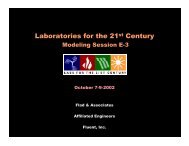Whitehead Biomedical Research Building at Emory University ... - I2SL
Whitehead Biomedical Research Building at Emory University ... - I2SL
Whitehead Biomedical Research Building at Emory University ... - I2SL
Create successful ePaper yourself
Turn your PDF publications into a flip-book with our unique Google optimized e-Paper software.
4L A B S F O R T H E 2 1 S T C E N T U R YThe general labs were designed for a ventil<strong>at</strong>ion r<strong>at</strong>eof 10 air changes per hour (ACH). The building has 69chemical fume hoods. Each of the fume hoods uses a valveto keep the airflow constant in case the duct st<strong>at</strong>ic pressurevaries. The building also includes 16 exhausted biosafetycabinets. The cabinets in the BL-3 area connect to the fumehood exhaust.The vivarium was first designed for 15 ACH but wasredesigned to 10 ACH when ventil<strong>at</strong>ed cages were selectedfor use in it. However, because the cages were notscheduled to be available when the building opened, thevivarium was redesigned back to 15 ACH. The cages wereadded l<strong>at</strong>er. A portion of the vivarium’s exhaust, fromrooms containing general animal housing, goes throughthe general exhaust. Exhaust air from animal rooms th<strong>at</strong>contain contaminants or p<strong>at</strong>hogens goes through the fumehood exhaust system.The vivarium exhaust represents about 4% of the totalvolume of air exhausted through the energy recoverywheels. At one point, however, it was found th<strong>at</strong> thevivarium exhaust didn’t mix as well as expected with thegeneral exhaust, and some odors were being recircul<strong>at</strong>edback into the building. The lesson learned from th<strong>at</strong>experience was to reduce the r<strong>at</strong>io of vivarium exhaustto general exhaust even further, to about 2%.Chilled w<strong>at</strong>er is supplied to the building from achilled w<strong>at</strong>er plant. The tonnage of cooling required wascomputed by allowing credit for the he<strong>at</strong> recovery fromthe enthalpy wheels, with one wheel offline for service <strong>at</strong>or near the peak design d<strong>at</strong>e. A central plant provides thebuilding with steam for he<strong>at</strong>ing.Design ApproachFrom the start, the project design reflected a commitmentto sustainable design practices. However, achievingthe LEED silver certific<strong>at</strong>ion did not become a design goaluntil a few months after construction began in March 1999,when <strong>Emory</strong> <strong>University</strong> decided to make LEED certific<strong>at</strong>ionmand<strong>at</strong>ory for all new campus projects, starting withthe <strong>Whitehead</strong> <strong>Research</strong> <strong>Building</strong>. Typically, planning forLEED certific<strong>at</strong>ion occurs during the early stages of thedesign process. In this case, however, the design teamwas already sensitive to the need to save energy and w<strong>at</strong>erand to integr<strong>at</strong>e the building into an overall campus planemphasizing pedestrian movement. So, the design teamneeded to incorpor<strong>at</strong>e only a few things to achieve asilver r<strong>at</strong>ing.The project delivery method was ConstructionManager At-Risk, with a fast-track, phased design documentprocess. After the construction of the first and thesecond packages (the found<strong>at</strong>ion and structure) of thisproject were well under way, cost reports showed th<strong>at</strong> thecompleted project would be $6 million over budget. Atth<strong>at</strong> point, the project team—including the designers, constructionmanager, and owner—went through an intensevalue engineering phase th<strong>at</strong> lasted 2 months. During th<strong>at</strong>phase, the team kept its focus on the life-cycle cost of theproject. They worked hard to protect the fe<strong>at</strong>ures of thebuilding th<strong>at</strong> made good business sense for the owner inthe long run, even though those fe<strong>at</strong>ures added to the firstcost. At the end of the value engineering phase, the projectteam was successful in bringing the project within strikingdistance of the budget.Technologies UsedThe building is on a site th<strong>at</strong> had been developedpreviously, increasing density without losing green space.A greenhouse already on the site was reloc<strong>at</strong>ed to anothersite on campus instead of being demolished. The newbuilding is served by <strong>Emory</strong>’s altern<strong>at</strong>ive transport<strong>at</strong>ionsystem, with no net increase in parking and a reductionin local vehicle emissions. To support this and other newprojects, <strong>Emory</strong> built a parking garage a few miles fromthe campus. A new shuttle road served by altern<strong>at</strong>ivelyfueled vehicles—both compressed gas and electricalones—allows <strong>Emory</strong> to ferry people back and forth fromthe parking area to the campus.The university also has a policy th<strong>at</strong> assures no netloss of the tree canopy. This means th<strong>at</strong>, for each treeremoved, one tree is planted elsewhere on campus.Energy EfficiencyThe primary str<strong>at</strong>egy for energy efficiency is touse the four 20-ft-diameter enthalpy wheels for energyrecovery. The enthalpy wheels recover he<strong>at</strong> energy fromexhaust air and use the air exhausted from the facility toprehe<strong>at</strong> outside air in the winter and to precool outside airin the summer. The wheels are in a mechanical penthouseroom on the top floor of the building; this mechanicalpenthouse is hidden from view by a sloped roof. The airintake is below the eve of the roof. An exterior view of thebuilding is shown in the photograph on page 1.The added first cost of the he<strong>at</strong> recovery system was$450,000, with a simple payback of about 4 years. Themechanical engineer convinced the design team of theusefulness of this fe<strong>at</strong>ure, and the owner had the foresightto see th<strong>at</strong> this was the right decision in the long run. Theirefforts helped to keep the wheels in the project during thecost-cutting phase.Return air from clean zones, such as offices, is mixedback into the supply air so th<strong>at</strong> supply air is approxim<strong>at</strong>ely75% outside air to all zones. This str<strong>at</strong>egy saves on theamount of air th<strong>at</strong> needs to be conditioned.
L A B S F O R T H E 2 1 S T C E N T U R Y 5An energy analysis was performed to compare thebuilding as designed with a base case building meetingAmerican Society of He<strong>at</strong>ing, Refriger<strong>at</strong>ing, and Air-Conditioning Engineers/Illumin<strong>at</strong>ing Engineering Societyof North America (ASHRAE/IENSA) standard 90.1-1999.Expected annual savings include 2161 MBtu of he<strong>at</strong>ingfuel and 3.4 million kWh of electricity, or $167,730 inenergy costs. This takes into account the savings fromdaylighting controls and high-efficiency equipment. Andit transl<strong>at</strong>es into a 22.2% overall energy savings, whencompared with the base case.System design decisions were made on a life-cyclecost basis, and a “value management” process wasemployed to ensure th<strong>at</strong> cost-reduction decisions didnot reduce the facility’s long-term value to the university.For the energy recovery system alone, the internal r<strong>at</strong>e ofreturn on a $450,000 investment yielding $136,028 annuallyover 10 years would be 28% (this assumes no escal<strong>at</strong>ionin utility costs over th<strong>at</strong> time). If costs and benefits of otherefficiency measures were taken into consider<strong>at</strong>ion, theactual r<strong>at</strong>e of return rel<strong>at</strong>ive to a code-compliant facilitywould be significantly gre<strong>at</strong>er.The ventil<strong>at</strong>ed cages used in the viviarium provideseveral opportunities for energy and m<strong>at</strong>erial savingsand health benefits to occupants. The system used in the<strong>Whitehead</strong> <strong>Building</strong> provides supply and exhaust airdirectly to and from each individual cage. And the systemallows a reduction in the ventil<strong>at</strong>ion air r<strong>at</strong>e from 15 ACHto 10 ACH. In new construction, this could allow a reductionin the size of the fans serving the vivarium. The ventil<strong>at</strong>edracks also keep the corncob bedding drier, so th<strong>at</strong> itmust be changed only every 14 days r<strong>at</strong>her than every7 days. The ventil<strong>at</strong>ed racks provide health benefits forworkers and reduce the spread of allergens.Daylighting and LightingNinety percent of the building’s lab and office spacesline the perimeter and include windows to the outside.Thus, the vast majority of occupied rooms receive n<strong>at</strong>urallight during the day. The building’s perimeter electriclighting system is tied to an on/off switch controlled by aphotocell (with manual overrides) to control the row oflights parallel to the window. These lights are autom<strong>at</strong>icallyswitched off when there is adequ<strong>at</strong>e n<strong>at</strong>ural lighting.Each 2500-ft 2 zone in lab areas has six 3-way switchesto control lights. Individual offices and small rooms usemotion detector lighting controls. The lighting inside thebuilding uses T-8 lamps with electronic ballasts in twolamp,1x4 recessed parabolic fixtures loc<strong>at</strong>ed directlyover each bench. The lighting level <strong>at</strong> bench top is 75 footcandles.W<strong>at</strong>er Efficiency<strong>Emory</strong> <strong>University</strong> incorpor<strong>at</strong>ed several w<strong>at</strong>er-savingmeasures into this project. These include storm-w<strong>at</strong>erharvesting for irrig<strong>at</strong>ion, a condens<strong>at</strong>e recovery systemfor make-up w<strong>at</strong>er in cooling towers, and advancedcage-washing techniques.The building’s storm-w<strong>at</strong>er harvesting system capturesw<strong>at</strong>er from the roof and the outdoor plaza andmoves it to a large retention vault bene<strong>at</strong>h the plaza. Thew<strong>at</strong>er is then filtered and reused for site irrig<strong>at</strong>ion. FultonCounty required <strong>Emory</strong> to build a retention vault to slowdown the runoff of storm w<strong>at</strong>er from the roof and thesite. When they decided to go for LEED certific<strong>at</strong>ion, the<strong>Emory</strong> design team made the underground retentionvault 3 feet deeper so it would hold about 70,000 gallonsof w<strong>at</strong>er. They also added a filter, a pump, and a bit ofpiping to connect this c<strong>at</strong>chment area into the site’sirrig<strong>at</strong>ion system. Figure 2 shows the retention vaultunder construction.In addition, the design team recognized th<strong>at</strong> the airconditioningsystem would cre<strong>at</strong>e a tremendous amountof condens<strong>at</strong>e w<strong>at</strong>er. So, they decided to pipe the condens<strong>at</strong>efrom the AHUs and chilled w<strong>at</strong>er coils back intonearby cooling towers for use as make-up w<strong>at</strong>er. Thissystem not only conserves w<strong>at</strong>er, it also diverts an estim<strong>at</strong>ed2.5 million gallons a year from the county’s sanitarysewer system, saving energy and money as well.The vivarium includes a st<strong>at</strong>e-of-the-art, autom<strong>at</strong>edcage-washing system. The cage washer, which was manufacturedin Finland, is one of the first ones installed in theUnited St<strong>at</strong>es. It saves energy, w<strong>at</strong>er, and chemicals byrecycling w<strong>at</strong>er through four stages of cleaning using acounter-current rinsing process. In counter-current rinsing,the flow of rinse w<strong>at</strong>er for cage washing is the oppo-Figure 2. Retention vaultStuart Lewis, HOK/PIX
6L A B S F O R T H E 2 1 S T C E N T U R YFigure 3. Robotics used in cage washing oper<strong>at</strong>ionsite of th<strong>at</strong> of the workflow. In other words, the cleanestw<strong>at</strong>er is used only for the final rinsing stage; w<strong>at</strong>er forearly rinsing tasks, in which the quality of rinse w<strong>at</strong>er isnot as important, is w<strong>at</strong>er th<strong>at</strong> was previously used in thel<strong>at</strong>er stages of rinsing oper<strong>at</strong>ions. An autom<strong>at</strong>ed processusing robotics disposes of the dirty bedding, feeds thecages through a washer, fills the clean cages with cleanbedding, and replaces cages in the racks. This has elimin<strong>at</strong>edmuch of the manual labor associ<strong>at</strong>ed with this task.Figure 3 shows the robotics.A central plant system is used for cooling. The coolingload, and thus the amount of chilled w<strong>at</strong>er needed, isreduced approxim<strong>at</strong>ely 20% by the oper<strong>at</strong>ion of theenthalpy wheels.Indoor Environmental QualityTo protect the building’s indoor air quality, paintsand adhesives with low levels of vol<strong>at</strong>ile organic compounds,or VOCs, were used, and it has been design<strong>at</strong>eda nonsmoking facility. During construction, a managementplan was implemented to prevent the contamin<strong>at</strong>ionof building m<strong>at</strong>erials by w<strong>at</strong>er, dirt, and other sources ofpollutants. Before the staff moved in, the office areas wereflushed with 100% outside air.Sandy Mendler, AIA, HOK/PIXM<strong>at</strong>erialsThe building m<strong>at</strong>erials incorpor<strong>at</strong>e products (such aslab counters) th<strong>at</strong> are manufactured using post-consumerand post-industrial waste. In addition, the constructionfe<strong>at</strong>ured m<strong>at</strong>erials th<strong>at</strong> are manufactured locally, reducingenergy used for transport<strong>at</strong>ion. <strong>Emory</strong> also followed aconstruction recycling plan. They recycled 300 tons ofmetal and saved about $20,000 by being conscientiousabout recycling.Measurement and Evalu<strong>at</strong>ionApproachMeters were installed <strong>at</strong> the main switchboard totrack electrical loads off individual feeder lines as well asto measure the use of steam and w<strong>at</strong>er, including chilledw<strong>at</strong>er. Electric power and steam usage is reported inTable 2.Commissioning<strong>Emory</strong>’s standard approach is to commission all newbuildings before they open for business. This includescommissioning all the building systems to ensure th<strong>at</strong>they are oper<strong>at</strong>ing in the intended ways. The ownersbelieve th<strong>at</strong>, while commissioning improves the efficiencyof most buildings, it is especially important for labor<strong>at</strong>orybuildings, which use a large amount of energy and havespecial safety requirements as well as sophistic<strong>at</strong>ed controlsystems, like fume hoods.<strong>Building</strong> MetricsIn Table 2, d<strong>at</strong>a on annual energy use th<strong>at</strong> was estim<strong>at</strong>edfrom design parameters is compared with actualmetered d<strong>at</strong>a summed from three electric meters andmetered steam d<strong>at</strong>a. The metered d<strong>at</strong>a were tabul<strong>at</strong>ed for2 years for comparison purposes and were similar in bothyears; the table shows annual d<strong>at</strong>a for May 2003 throughApril 2004. Metered d<strong>at</strong>a are 20% lower than the estim<strong>at</strong>e.This is generally the case in labor<strong>at</strong>ories fe<strong>at</strong>ured inLabs 21 case studies because the estim<strong>at</strong>es are usuallyconserv<strong>at</strong>ive, and they take into account only very generalusage inform<strong>at</strong>ion. Since the cooling load <strong>at</strong> the centralplant was not accounted for by the building’s electricmeters, an estim<strong>at</strong>e for cooling was added to the d<strong>at</strong>a foractual energy use measured <strong>at</strong> the building. W<strong>at</strong>er use <strong>at</strong>this facility was measured <strong>at</strong> 11,715,000 gallons per year.
L A B S F O R T H E 2 1 S T C E N T U R Y 7Table 2. <strong>Whitehead</strong> <strong>Biomedical</strong> <strong>Research</strong> Center <strong>Building</strong> MetricsSystem Key Design Parameters Annual Energy Usage Estim<strong>at</strong>e(based on design d<strong>at</strong>a)Ventil<strong>at</strong>ion (sum ofw<strong>at</strong>tage of all thesupply fans and all theexhaust fans)Supply = 1.0 W/cfmExhaust = 1.25 W/cfmTotal = 1.13 W/cfm (1)(1.0 cfm/gross ft 2 ; 1.5 cfm/net ft 2and 2.1 cfm/gross ft 2 of labs) (2) 19.8 kWh/gross ft 2 (3) NACooling plant 2300 tons, 1.0 kW/ton 20.4 kWh/gross ft 2 (4) NALighting 1.6 W/ft 2 average 7.25 kWh/gross ft 2 (5) NAProcess/Plug 11 W/net ft 2 32.4 kWh/gross ft 2 (6) NAAnnual Energy Use(based on measured d<strong>at</strong>a)He<strong>at</strong>ing plant Not available Not available 68,298,447 pounds of steamTotal79.85 kWh/gross ft 2 /yr(estim<strong>at</strong>e based on design d<strong>at</strong>afor electricity only)272 kBtu/gross ft 2 /yr forelectricity only42.90 kWh/gross ft 2 /yr for electricity only (basedon metered d<strong>at</strong>a from 05/03 – 04/04)Since cooling is provided by a central plant, theestim<strong>at</strong>e of 20.4 kWh/gross ft 2 /yr is added back inTotal electrical energy = 63.3 kWh/gross ft 2 /yr(222.6 kBtu/gross ft 2 /yr)Steam = 210 kBtu/gross ft 2 /yr432.6 kBtu/gross ft 2 for electricity, cooling (est.)and steamNotes:1. W/cfm for supply air = 910 hp x 746 W/hp/681,000 cfm (supply) = 1.0 W/cfm; for exhaust air = 530.5 hp x 746 W/hp/317,040 cfm = 1.25 W/cfm; average = 1.13(based on namepl<strong>at</strong>e r<strong>at</strong>ing d<strong>at</strong>a).2. 317,040 cfm (total cfm based on exhaust)/212,265 net ft 2 = 1.5 cfm/net ft 2 ; 317,040 cfm/325,000 gross ft 2 = 1.0 cfm/gross ft 2 ; 317,040 cfm/148,000 net ft 2 of labs= 2.1 cfm/net ft 2 of labs.3. 1.13 W/cfm x 1.0 cfm/gross ft 2 x 8760 hours x 2/1000 = 19.8 kWh/gross ft 2 (30.5 kWh/net ft 2 ).4. 1 kW/ton x 2300 tons x 2890 hours/325,000 gross ft 2 = 20.4 kWh/gross ft 2 (assumes cooling runs 33% of the hours in a year).5. 1.6 W/gross ft 2 x 4534 hours/1000 = 7.25 kWh/gross ft 2 (2.46 W/net ft 2 x 0.65 = 1.6W/gross ft 2 ) (assumes lights are on 87.2 hours\week).6. 7.71 W/gross ft 2 x 0.80 x 5256 hours/1000 = 32.4 kWh/gross ft 2 (11 W/net ft 2 x 0.65 = 7.71 W/gross ft 2 ) (assumes th<strong>at</strong> 80% of all equipment is oper<strong>at</strong>ing 60% of thehours in a year).7. Estim<strong>at</strong>ed d<strong>at</strong>a are presented in site Btu (1 kWh = 3412 Btu). To convert to source Btu, multiply site Btu for electricity by 3. Note: Atlanta has approx. 3089 he<strong>at</strong>ingdegree-days and 1611 cooling degree-days (based on we<strong>at</strong>her d<strong>at</strong>a for Atlanta, GA).SummaryThe <strong>Whitehead</strong> <strong>Biomedical</strong> <strong>Research</strong> <strong>Building</strong> designteam was sensitive to the need to save energy and w<strong>at</strong>erand to integr<strong>at</strong>e the building into an overall, pedestrianfriendlycampus plan. These became key factors in thesuccess of this building as a high-performance labor<strong>at</strong>ory.The mechanical engineer advoc<strong>at</strong>ed the use of energyrecovery wheels early in the process, and they are integr<strong>at</strong>edeffectively into the building’s architecture under asloped roof. The design team also strongly emphasizedw<strong>at</strong>er efficiency by incorpor<strong>at</strong>ing an underground w<strong>at</strong>erstorage vault for storm w<strong>at</strong>er to use in irrig<strong>at</strong>ing the site,and by piping air-conditioning condens<strong>at</strong>e from the airhandlingunits and chilled w<strong>at</strong>er coils back into nearbycooling towers for use as make-up w<strong>at</strong>er.<strong>Emory</strong> <strong>University</strong>’s strong commitment to sustainabilityis evident in building designs th<strong>at</strong> are guided bya comprehensive master plan for the campus th<strong>at</strong> includesreplacing cars and concrete with green spaces and walkways.<strong>Emory</strong>’s tree canopy policy also makes it a leaderin the university community for environmental responsibility.In addition, the university requires all new buildingsto achieve a LEED silver certific<strong>at</strong>ion r<strong>at</strong>ing.
8L A B S F O R T H E 2 1 S T C E N T U R YAcknowledgementsThis case study would not have been possible withoutthe contributions of Rohit Saxena, AIA, and Stuart Lewis,AIA of HOK Architects in Atlanta, GA; Bill Nottingham,PE, and Tim Trotter, PE, of Nottingham, Brook andPennington in Macon, GA; and Laura Case of <strong>Emory</strong><strong>University</strong> in Atlanta. The author is gr<strong>at</strong>eful to all of themfor contributing their expertise, time, and valuable assistance.This case study was written by Nancy Carlisle of theN<strong>at</strong>ional Renewable Energy Labor<strong>at</strong>ory with assistancefrom Otto Van Geet, Paula Pitchford, editor, and SusanSczepanski, graphic artist, also of NREL.For More Inform<strong>at</strong>ionOn the <strong>Whitehead</strong> <strong>Biomedical</strong> <strong>Research</strong><strong>Building</strong>:Laura CaseFacility Manager<strong>Emory</strong> <strong>University</strong>638 Asbury Circle, <strong>Building</strong> CAtlanta, GA 30322404-727-5543lcase2@fmd.emory.eduOn Labor<strong>at</strong>ories for the 21st Century:Dan Amon, P.E.U.S. Environmental Protection Agency1200 Pennsylvania Ave., N.W. (3204R)Washington, DC 20460202-564-8234amon.dan@epa.govWill Lintner, P.E.U.S. Department of EnergyFederal Energy Management Program1000 Independence Ave., S.W.Washington, DC 20585202-586-3120william.lintner@ee.doe.govNancy Carlisle, AIAN<strong>at</strong>ional Renewable Energy Labor<strong>at</strong>ory1617 Cole Blvd.Golden, CO 80401303-384-7509nancy_carlisle@nrel.govRohit Saxena, AIAHOK, Science + Technology235 Peachtree Street, N.E.Suite 500Atlanta, GA 30303404-439-9222rohit.saxena@hok.comLabor<strong>at</strong>ories for the 21st CenturyU.S. Environmental Protection AgencyOffice of Administr<strong>at</strong>ion and Resources Managementwww.labs21century.govIn partnership with theU.S. Department of EnergyEnergy Efficiency and Renewable EnergyBringing you a prosperous future where energy is clean,abundant, reliable, and affordablewww.eere.energy.govPrepared <strong>at</strong> theN<strong>at</strong>ional Renewable Energy Labor<strong>at</strong>oryA DOE n<strong>at</strong>ional labor<strong>at</strong>oryDOE/GO-102005-2046April 2005Printed with a renewable-source ink on paper containing <strong>at</strong> least50% wastepaper, including 20% postconsumer waste




